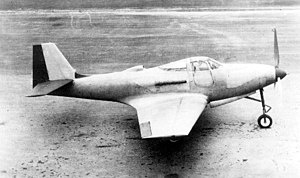The Bell P-76 was the proposed designation for a production model derivative of the XP-39E, a single-engine American fighter aircraft prototype of World War II.
| P-76 | |
|---|---|

| |
| XP-39E, the prototype of the P-76 | |
| Role | Fighter aircraft |
| Manufacturer | Bell Aircraft Corporation |
| First flight | 1942 |
| Status | Did not enter mass-production |
| Primary user | United States Army Air Forces |
| Number built | 0 (3 prototypes built as XP-39Es) |
| Developed from | Bell P-39 Airacobra |
Design and development
editOn 26 February 1941 the United States Army Air Corps (USAAC) placed a contract with Bell allowing for the purchase of two XP-39Es (41-19501 and 41-19502) which were envisaged to be a major improvement on the P-39D series. Because of the number of changes proposed the production model was to be called the Bell P-76.
The Bell P-76 was proposed to address the poor high-altitude performance of the P-39 Airacobra by incorporating a new and thicker wing with a symmetrical airfoil; the section chosen was NACA 0018 at the wing-root tapering to an NACA 23009 at the tip. Although the new wing has often been referred to as a laminar flow type, this was not the case.[1] The wing span was increased to 35 ft 10 in (10.9 m) and the area to 236 ft2 (21.9 m2), the thicker wing allowing an increase in the fuel capacity to 150 US gallons (568 L).[2]
Design of a new Allison V-1710-E9 was also underway. This version, which had the military designation of V-1710-47, used a two-stage mechanical supercharger to increase the engine power at altitude. However, this engine went through so many design changes that it ended up being almost identical to the later V-1710-93 which was fitted in the XP-63A.[2]
Another change was the engine bay was modified to accept a more powerful engine in lieu of the V-1710. Its origins lie in the 1941 project to equip three P-39D (41-19501, 41-19502 and 42-7164) with the Continental V-1430-1 liquid-cooled supercharged engine. The resultant XP-39E had a symmetrical airfoil wing with square wingtips, an elongated fuselage to accommodate the larger engine, and revised air intakes and radiators. The three prototypes each had a different tailfin. Since the Continental engine was not available at rollout, the prototypes flew with Allison V-1710-47 engines. In 1942, the XP-39E was redesignated P-76. Although 4,000 aircraft were initially ordered, the order was cancelled to permit the Bell factory to manufacture B-29 Superfortress bomber aircraft under license from Boeing. Many of the lessons learned in the P-76 were implemented in the subsequent P-63 Kingcobra.
Specifications (P-76)
editGeneral characteristics
- Crew: 1
- Length: 31 ft 11 in (9.7 m)
- Wingspan: 35 ft 10 in (10.9 m)
- Wing area: 236 sq ft (21.9 m2)
- Empty weight: 6,936 lb (3,150 kg)
- Max takeoff weight: 8,918 lb (4,050 kg)
- Powerplant: 1 × Continental I-1430-1 , 2,100 hp (1,600 kW)
Performance
- Maximum speed: 386 mph (620 km/h, 335 kn) at 21,680 ft (6,600 m)
- Rate of climb: 2,150 ft/min (11 m/s)
Armament
- Guns:
- 1× 37 mm (1.46 in) Oldsmobile T9 cannon, 30 rounds
- 2× 0.50 in (12.7 mm) M2 Browning machine guns, 200 rounds per gun
- 4× 0.30 in (7.62 mm) M1919 machine guns, 1,000 rounds per gun
- Bombs: 500 lb (227 kg) externally
See also
editRelated development
Related lists
References
editCitations
edit- ^ UIUC incomplete guide to Airfoil usage Archived 2008-05-15 at the Wayback Machine Retrieved: 9 August 2008
- ^ a b Bowers 1979, pp.21-25.
Bibliography
edit- Bowers, Peter M. "Airborne Cobra Pt.II". Airpower magazine, Vol.9, No.1, January 1979.